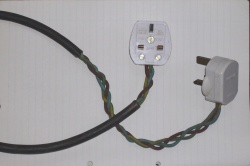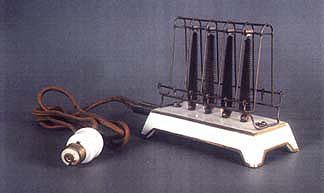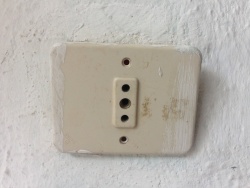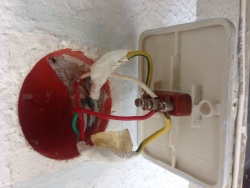Difference between revisions of "Bad Ideas - Electrical"
| (4 intermediate revisions by the same user not shown) | |||
| Line 1: | Line 1: | ||
| + | [[image:Diode fuse 4888-3.jpg|200px|right]] | ||
| + | [[image:Braided mains lead 0765-5.jpg|250px|right]] | ||
| + | |||
Things to Avoid Doing! | Things to Avoid Doing! | ||
| − | |||
===Single whole house RCD=== | ===Single whole house RCD=== | ||
| − | A single appliance earth fault, or assorted non-fault conditions, will cut your whole supply off. Not very good if you like lights and a working freezer, and don't have Sherlock Holmes on hand to figure out where in the system the problem lies. | + | A single [[appliance]] [[earth]] fault, or assorted non-fault conditions, will cut your whole supply off. Not very good if you like lights and a working freezer, and don't have Sherlock Holmes on hand to figure out where in the system the problem lies. |
===Freezer sharing RCD with half the house wiring=== | ===Freezer sharing RCD with half the house wiring=== | ||
| − | Any RCD trip is liable to ruin your freezer contents. A common setup in new installations unfortunately. | + | Any [[RCD]] trip is liable to ruin your freezer contents. A common setup in new installations until very recently, unfortunately. |
===Plugin electric heating=== | ===Plugin electric heating=== | ||
| − | One of the most expensive heating methods of all. Can also lead to overloaded sockets and extension leads, causing a fire risk | + | One of the most expensive heating methods of all. Can also lead to overloaded sockets and extension leads, causing a [[fire]] risk |
===Historic rubber wiring=== | ===Historic rubber wiring=== | ||
| − | Old rubber wiring is regularly very badly perished, leaving bare uninsulated wires intertwined in unsuitable places. High risk of fire and shock. | + | Old rubber wiring is regularly very badly perished, leaving bare uninsulated wires intertwined in unsuitable places. High risk of [[fire]] and shock. |
===Disturbing historic rubber wiring=== | ===Disturbing historic rubber wiring=== | ||
| − | A quarter inch of movement is enough to cause a short where wiring is badly perished. Shorts cause shock and fire, or blow supply | + | A quarter inch of movement is enough to cause a short where wiring is badly perished. Shorts cause shock and fire, or blow supply [[fuse]]s. Historic rubber wire should normally be left alone until replacement, unless it can be verified that the insulation is still in one piece. |
===Fitting a mains drill with an RCD=== | ===Fitting a mains drill with an RCD=== | ||
| Line 22: | Line 24: | ||
===Showers wired on 2.5 mm^2 T&E=== | ===Showers wired on 2.5 mm^2 T&E=== | ||
| − | Cable used like this is a fire risk and does not last | + | Cable used like this is a [[fire]] risk and does not last well. One exception is old 3kW showers which are ok on [[Cable|2.5 T&E]], most people nowadays aren't happy with the resulting flow rate though. |
===Showers that give you a tingle or shock=== | ===Showers that give you a tingle or shock=== | ||
| Line 28: | Line 30: | ||
===Plastic waterpipe earth=== | ===Plastic waterpipe earth=== | ||
| − | Houses generally used to use the metal supply waterpipe as an earth, and a good earth it was. But today many water supplies have been replaced with plastic pipe, which may leave the house with no earth connection. This is a real shock hazard. | + | Houses generally used to use the metal supply waterpipe as an earth, and a good [[earth]] it was. But today many [[water]] supplies have been replaced with plastic pipe, which may leave the house with no earth connection. This is a real shock hazard. |
===Local earth rod & no RCD or ELCB=== | ===Local earth rod & no RCD or ELCB=== | ||
| − | + | Common on 1950s installs and older, but sometimes found on much more modern systems. Often results in no effective earth protection, as earth fault currents will neither blow a [[fuse]] nor be kept down to a safe voltage by the earth rod. | |
===High Tech Appliances=== | ===High Tech Appliances=== | ||
[[image:Light_fitting_plug_with_toaster.jpg|400px]] | [[image:Light_fitting_plug_with_toaster.jpg|400px]] | ||
| + | |||
| + | ===Colour code madness=== | ||
| + | [[image:image4p.jpg|right|250px]] | ||
| + | [[image:image2.jpg|right|250px]] | ||
| + | |||
| + | Behind this Spanish socket lurks madness. The middle pin (red, white) is earth, and the green/yellow striped wires are both live & neutral. So of the 2 red [[Cable|wires]], one is earth the other live. | ||
| + | |||
[[Category:Bad Ideas]] | [[Category:Bad Ideas]] | ||
[[Category:Electrical]] | [[Category:Electrical]] | ||
Latest revision as of 20:23, 2 September 2018
Things to Avoid Doing!
Single whole house RCD
A single appliance earth fault, or assorted non-fault conditions, will cut your whole supply off. Not very good if you like lights and a working freezer, and don't have Sherlock Holmes on hand to figure out where in the system the problem lies.
Freezer sharing RCD with half the house wiring
Any RCD trip is liable to ruin your freezer contents. A common setup in new installations until very recently, unfortunately.
Plugin electric heating
One of the most expensive heating methods of all. Can also lead to overloaded sockets and extension leads, causing a fire risk
Historic rubber wiring
Old rubber wiring is regularly very badly perished, leaving bare uninsulated wires intertwined in unsuitable places. High risk of fire and shock.
Disturbing historic rubber wiring
A quarter inch of movement is enough to cause a short where wiring is badly perished. Shorts cause shock and fire, or blow supply fuses. Historic rubber wire should normally be left alone until replacement, unless it can be verified that the insulation is still in one piece.
Fitting a mains drill with an RCD
...in the mistaken belief that this offers some protection if you drill into a live wire. It gives no such protection, but encourages less care to be taken over where one drills, thus increases the danger.
Showers wired on 2.5 mm^2 T&E
Cable used like this is a fire risk and does not last well. One exception is old 3kW showers which are ok on 2.5 T&E, most people nowadays aren't happy with the resulting flow rate though.
Showers that give you a tingle or shock
There are normally several layers of protection against this occurring with showers, if a shower reaches this point the installation is in a terrible state and may fry you at any time. All users of such showers are automatically nominated for the prestigious Darwin Award.
Plastic waterpipe earth
Houses generally used to use the metal supply waterpipe as an earth, and a good earth it was. But today many water supplies have been replaced with plastic pipe, which may leave the house with no earth connection. This is a real shock hazard.
Local earth rod & no RCD or ELCB
Common on 1950s installs and older, but sometimes found on much more modern systems. Often results in no effective earth protection, as earth fault currents will neither blow a fuse nor be kept down to a safe voltage by the earth rod.
High Tech Appliances
Colour code madness
Behind this Spanish socket lurks madness. The middle pin (red, white) is earth, and the green/yellow striped wires are both live & neutral. So of the 2 red wires, one is earth the other live.




